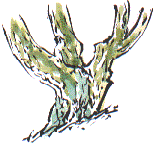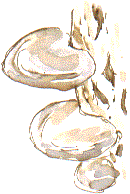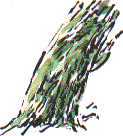Nature Diary
Rocks
History
Gallery
Links
Home Page
 THERE ARE steep slopes where the valley cuts through beds of sandstone. Sessile Oak and Silver Birch grow on the drier slopes, Alder and Hazel seem to prefer the soils by the stream, as does Crack Willow, which also grows on the bed of a silted-up dam in the valley bottom.
THERE ARE steep slopes where the valley cuts through beds of sandstone. Sessile Oak and Silver Birch grow on the drier slopes, Alder and Hazel seem to prefer the soils by the stream, as does Crack Willow, which also grows on the bed of a silted-up dam in the valley bottom.
 The multi-trunked oaks are trees that were coppiced when young. There's been some cutting back of oaks below the power lines this winter. They haven't been cut right back to ground, or even back to the top of the trunk, so you'd call this trimming or pruning, rather than coppicing or pollarding.
The multi-trunked oaks are trees that were coppiced when young. There's been some cutting back of oaks below the power lines this winter. They haven't been cut right back to ground, or even back to the top of the trunk, so you'd call this trimming or pruning, rather than coppicing or pollarding.
The bark of the oaks is almost entirely coloured bright green by the powdery growth of Pleurococcus algae. There are also crusty patches of a bluish grey-green lichen Lecanora conizaeoides.
  In places on the slopes many of the Silver Birches are dying back. They have been attacked by Birch Bracket Fungus. Birches tend to be short-lived trees. They are effective at colonising open ground. They act as a nurse crop for the oaks, which are now growing up to shade them out. The birches have moss growing on their rough bark from the ground up to about knee-level. The upper bark is smooth and white, with distinctive diamond-shaped scars, which do not occur on other species of birch.
In places on the slopes many of the Silver Birches are dying back. They have been attacked by Birch Bracket Fungus. Birches tend to be short-lived trees. They are effective at colonising open ground. They act as a nurse crop for the oaks, which are now growing up to shade them out. The birches have moss growing on their rough bark from the ground up to about knee-level. The upper bark is smooth and white, with distinctive diamond-shaped scars, which do not occur on other species of birch.
 By comparison, Hazel is lacking in growths of lichen and algae. This may be because the smooth silver-grey bark doesn't give them much of surface to start growing on. The bark is lined by horizontal scars.
By comparison, Hazel is lacking in growths of lichen and algae. This may be because the smooth silver-grey bark doesn't give them much of surface to start growing on. The bark is lined by horizontal scars.
 The Crack Willows have the most luxuriant growth of moss. Not only do they have rough bark where the moss can get a foothold, they also grow in the most humid and sheltered part of the wood. Cavities where old branches have broken away can become natural container gardens, colonised by bramble and seedling trees.
The Crack Willows have the most luxuriant growth of moss. Not only do they have rough bark where the moss can get a foothold, they also grow in the most humid and sheltered part of the wood. Cavities where old branches have broken away can become natural container gardens, colonised by bramble and seedling trees.

Richard Bell,
wildlife illustrator
E-mail; 'richard@daelnet.co.uk'
Next day
Previous day
Nature Diary
Wild West Yorkshire home page
|
 THERE ARE steep slopes where the valley cuts through beds of sandstone. Sessile Oak and Silver Birch grow on the drier slopes, Alder and Hazel seem to prefer the soils by the stream, as does Crack Willow, which also grows on the bed of a silted-up dam in the valley bottom.
THERE ARE steep slopes where the valley cuts through beds of sandstone. Sessile Oak and Silver Birch grow on the drier slopes, Alder and Hazel seem to prefer the soils by the stream, as does Crack Willow, which also grows on the bed of a silted-up dam in the valley bottom.
 The multi-trunked oaks are trees that were coppiced when young. There's been some cutting back of oaks below the power lines this winter. They haven't been cut right back to ground, or even back to the top of the trunk, so you'd call this trimming or pruning, rather than coppicing or pollarding.
The multi-trunked oaks are trees that were coppiced when young. There's been some cutting back of oaks below the power lines this winter. They haven't been cut right back to ground, or even back to the top of the trunk, so you'd call this trimming or pruning, rather than coppicing or pollarding.
 In places on the slopes many of the Silver Birches are dying back. They have been attacked by Birch Bracket Fungus. Birches tend to be short-lived trees. They are effective at colonising open ground. They act as a nurse crop for the oaks, which are now growing up to shade them out. The birches have moss growing on their rough bark from the ground up to about knee-level. The upper bark is smooth and white, with distinctive diamond-shaped scars, which do not occur on other species of birch.
In places on the slopes many of the Silver Birches are dying back. They have been attacked by Birch Bracket Fungus. Birches tend to be short-lived trees. They are effective at colonising open ground. They act as a nurse crop for the oaks, which are now growing up to shade them out. The birches have moss growing on their rough bark from the ground up to about knee-level. The upper bark is smooth and white, with distinctive diamond-shaped scars, which do not occur on other species of birch. By comparison, Hazel is lacking in growths of lichen and algae. This may be because the smooth silver-grey bark doesn't give them much of surface to start growing on. The bark is lined by horizontal scars.
By comparison, Hazel is lacking in growths of lichen and algae. This may be because the smooth silver-grey bark doesn't give them much of surface to start growing on. The bark is lined by horizontal scars. The Crack Willows have the most luxuriant growth of moss. Not only do they have rough bark where the moss can get a foothold, they also grow in the most humid and sheltered part of the wood. Cavities where old branches have broken away can become natural container gardens, colonised by bramble and seedling trees.
The Crack Willows have the most luxuriant growth of moss. Not only do they have rough bark where the moss can get a foothold, they also grow in the most humid and sheltered part of the wood. Cavities where old branches have broken away can become natural container gardens, colonised by bramble and seedling trees.